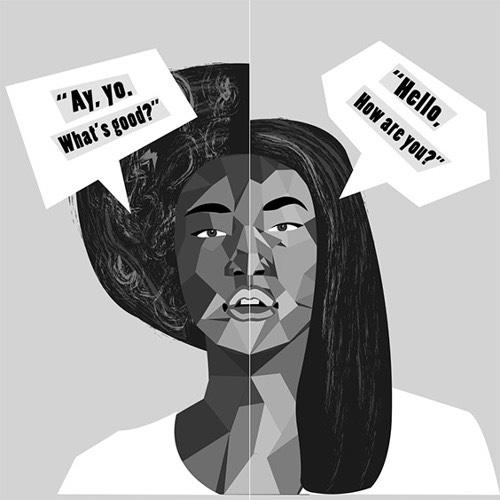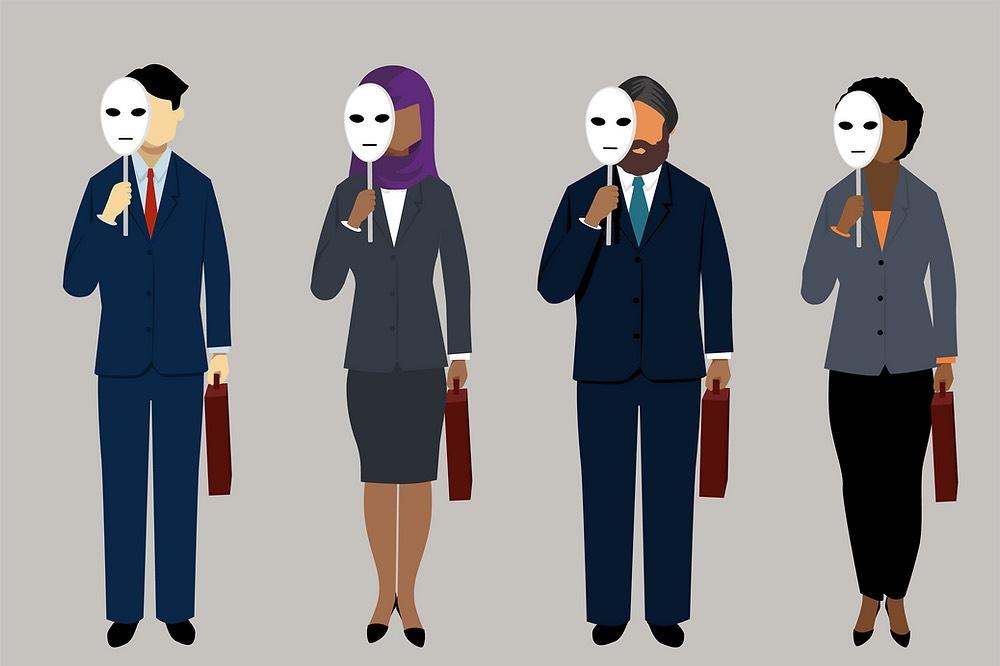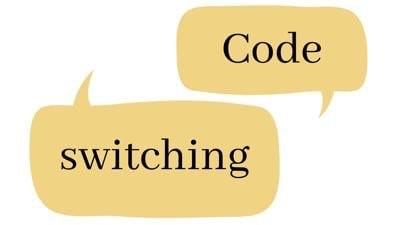By Nicole Manning
Have you ever changed the way you speak, act, or even write, based on the person you are talking to, or the setting you are in? That is the inevitable, unconscious force of “code-switching;” a social habit which impacts us at work or at school,with friends, colleagues, and family. When sociolinguistics scholar Einar Hagen coined the term in 1954, I don’t think he could have anticipated a word he created just to describe how people inter-changed languages and dialects, to become a survival tactic among international members of the Black, Indigenous and People of Color(BIPOC) communities.
Among these groups, code-switching means changing up social-behaviors, language, and appearance in order to assimilate into what is considered the norms and standards of the environment. Code-switching has always been a vital form of adaptive communication that allows people of color to thrive, interact, grow, and exceed expectations or stereotypes in both social and professional settings.
Code-Switching is often a strategic tool that helps people of color to navigate interracial interactions and relationships. Used consciously or unconsciously, it can lead to advantageous opportunities for the user’s economic advancement, or sometimes even physical survival. This form of communication is ordinarily divided into two categories—language-based and cultural-based code-switching.
Language-based code-switching is when you change your language and dialect in order to indicate compliance/identification with the predominant culture. One example of this might be when someone who is bilingual automatically speaks one language at home or with friends, and another at school or in a more professional setting.
Cultural-based code-switching is similar to language-based code-switching, but it transforms people much more extensively. Switching cultural codes generally involves adjusting one’s style of speech, appearance, behavior, and facial expressions in ways that will maximize the comfort of others in exchange for equal (or favorable) treatment not only in a workplace or academic setting, but also to ‘fit in’ within your friend group. (For example, one might adopt or avoid wearing specific attire, or wearing their hair in a certain way, to avoid being associated with a specific culture or religion.)
Strategic styles of cultural code-switching date back to before the 16th century, when foreign merchants would travel through international trading networks that were composed of many different cultures and religions. However, more recent examples can be seen in the 19th century during slavery, when African-Americans would wear the mask of the “obedient slave” to survive the brutal, inhumane circumstances that slave owners forced them into.
As time went on in the post-colonial, racially mixed nations of the 20th century, code-switching took on a new meaning. It now refers to any marginalized or underrepresented identity adapting to the dominant environment around them in any context,” (Washington-Harmon, 2020). Members of minority groups continue to make code-switching a crucial part of their daily routine, the better to shape and maintain an inclusive sense of identity and belonging to a larger community.
Code-switching tactics often start off being very subtle during our early academic careers and early job placements. However, as our lives, feelings, and goals become more complex, the use of code-switching becomes more intricate. In school, code-switching generally starts out with the idea of trying to be popular and ‘fit in’ with what is considered ‘cool’. This idea then gets routinely incorporated into our lives through adapting one’s behavior to mimic popular social trends, when in reality your personal style may be more relaxed and modest.
As we become older, the use of code-switching might be seen in the way one presents oneself professionally, and in one’s academic work. Where a student’s primary dialect may be African American vernacular at home and with friends, when that student speaks to teachers and peers at a job site, he or she switches to American Vernacular English because it is perceived to be more “proper” than ‘Black English’.
The same idea surfaces in the context of academic writing, in the struggle students may feel to write and express themselves in a way that is considered socially appropriate. In an article published by Teen Vogue, Robinson Cook, a senior at the University of Wisconsin-Madison, described his burdensome experience with code-switching thusly: “If I could get away with it, I’d say exactly what I want to say the way I want to say it. But nobody wants that,” (Retta,2019).
At work the use of code-switching is a vital means for the BIPOC community to debunk the often negative and degrading stereotypes projected onto them in their places of employment. In the workplace, many people of color are immediately perceived as incompetent, lazy, loud, too expressive, and so forth. This is why many of us feel the need to somehow transform ourselves to avoid the discrimination, tokenism (and in some cases termination), that can occur when blacks are told that their normal behaviors “disrupt” a predominantly white workplace.
The act of code-switching itself is beneficial to members of the BIPOC community who are trying to thrive in academic and professional environments that are often founded on the values of white culture. When a person from a stigmatized group (whether the stigma is based on religion, sexual orientation, gender, race, or ethnicity) is interacting with people from a nonstigmatized group, mimicking the latter group’s behaviors may help them advance in their career or even feel more included at school.
Although code-switching has become such a common, practical thing in our society, its use is often devalued, causing the majority of those who do it to struggle to reconcile these different versions of their identity. People code-switch in the workplace not only to be taken seriously by the clients, managers, and colleagues we need to impress; but often for self protection as well. Successful code-switching can ease any verbal or physical hostility that could arise whenever a member of the BIPOC community expresses their true identity.
Historically there has been a lack of effort in the workplace to allow visible nonconformity or to encourage bold individualism among workers. So people of color working within white-majority environments can feel their natural differences put them at an unfair disadvantage. They are sensitive to—and often feel oppressed by—the complex expectations and stereotypes that are immediately placed on them. Despite many equal opportunity campaigns mounted since the 1950s, corporations still haven’t done much to change how they select, evaluate, and promote their employees.
When marginalized people are forced to code-switch at a young age when it may not come naturally to them, this pressure to conform causes emotional stress. The pressure to code-switch can then trigger unjustified feelings of inferiority. Feeling inferior is itself a stressor, nurtured by institutionalized racism, gender bias, and classism. When a child internalizes these biases that linger in American society, they can cause lasting psychological damage.
So no matter how beneficial code switching can be to an adult’s career, if you learned to do it unconsciously as a result of a childhood fear of inferiority, it can have a negative effect on your personality. As an unconscious behavior, code-switching can become harmful if you are subconsciously repressing your own sense of identity just to try to find a common ground with others and feel “safe.”
In an article from PsychCentral, the community health psychologist Jameta Nicole Barlow, states: “When you cannot be your true and authentic self, there’s going to be some blowback… we’re constantly navigating these social exposures in interesting ways that are detrimental to our health,” (Wade, 2021). In other words, for racially marginalized people who feel the only way to succeed in school and the workplace is to conform to stereotypical “white” behavioral norms, this belief takes a major social and emotional toll. The mere accumulation of stress and anxiety caused by the effort to adapt to the dominant culture has a negative impact on one’s physical and mental performance.
Code-switching is not limited to the walls of a classroom or office, as it finds its way into nearly every human interaction in day-to-day life. There are unspoken guidelines and behavioral standards set for people of color, encouraging them to code-switch to survive. This fact has come to public attention more than ever due to recent live videos of violent police interactions and the subsequent rise of the Black Lives Matter movement. There is plenty of historical evidence showing how BIPOC men and women were almost always required to appear submissive to whites when interacting with them, and to conform to white peoples’ expectations. All of this was deemed necessary so as to not be viewed by white America as a threat or a predator just because of the color of their skin.
Sadly, this remains true even in the 21st century. A PBS station in association two other organizations and the Black Culture Connection, recently promoted a short film and safety guide for young activists and at-risk youth called, ‘Get Home Safely: 10 Rules of Survival’ to provide teens with 10 straightforward, simple ways to help them get home safe if stopped by the police. The harsh reality is that young people of the BIPOC community need to follow these guidelines (or have ‘the Talk’ with their parents), just so their family won’t see them in a body bag at the end of the day. BIPOC individuals are judged and tested every day, not daring to make one wrong move for fear of becoming (or being perceived as) a tragic statistic.
* * *
I myself have relied on the benefits and ‘protections’ that code-switching gives many people. It was a skill that I picked up from my parents after seeing the ways that my father would interact with different people to make them feel more at ease, or how my mother could code-switch so easily as if the identity she portrayed were truly her identity.
As young black woman I have been fortunate to be in academic and social environments that are very diverse. However, there have been instances where I enter an environment that may be predominately white, and I immediately feel the need to code-switch as a defense mechanism against all the unspoken stereotypes that are placed like chains on a black women. Nevertheless, I do have to say that code-switching has always been a vibrant part of my life; it has led me to interact with many different types of people, and be exposed to different opportunities for which I will always be grateful.
Code-switching seems so simple on the surface. In fact, it is something that almost everyone does. However, it is also a deep and complex process that allows human beings to stay connected and thrive in different environments all at once. As this future generation of young people continue breaking barriers and exceeding the limitations placed on the generations before them I hope that they will reshape academic environments and the workplace to be equally welcoming to people of every cultural background.
The next time you are in a new environment, try to be more conscious of your reactions and behavior. Even though it may seem beneficial in the moment to code-switch, think about the long-term effects of constantly giving in to a subtle social pressure to deny, hide, or misrepresent who you really are.


